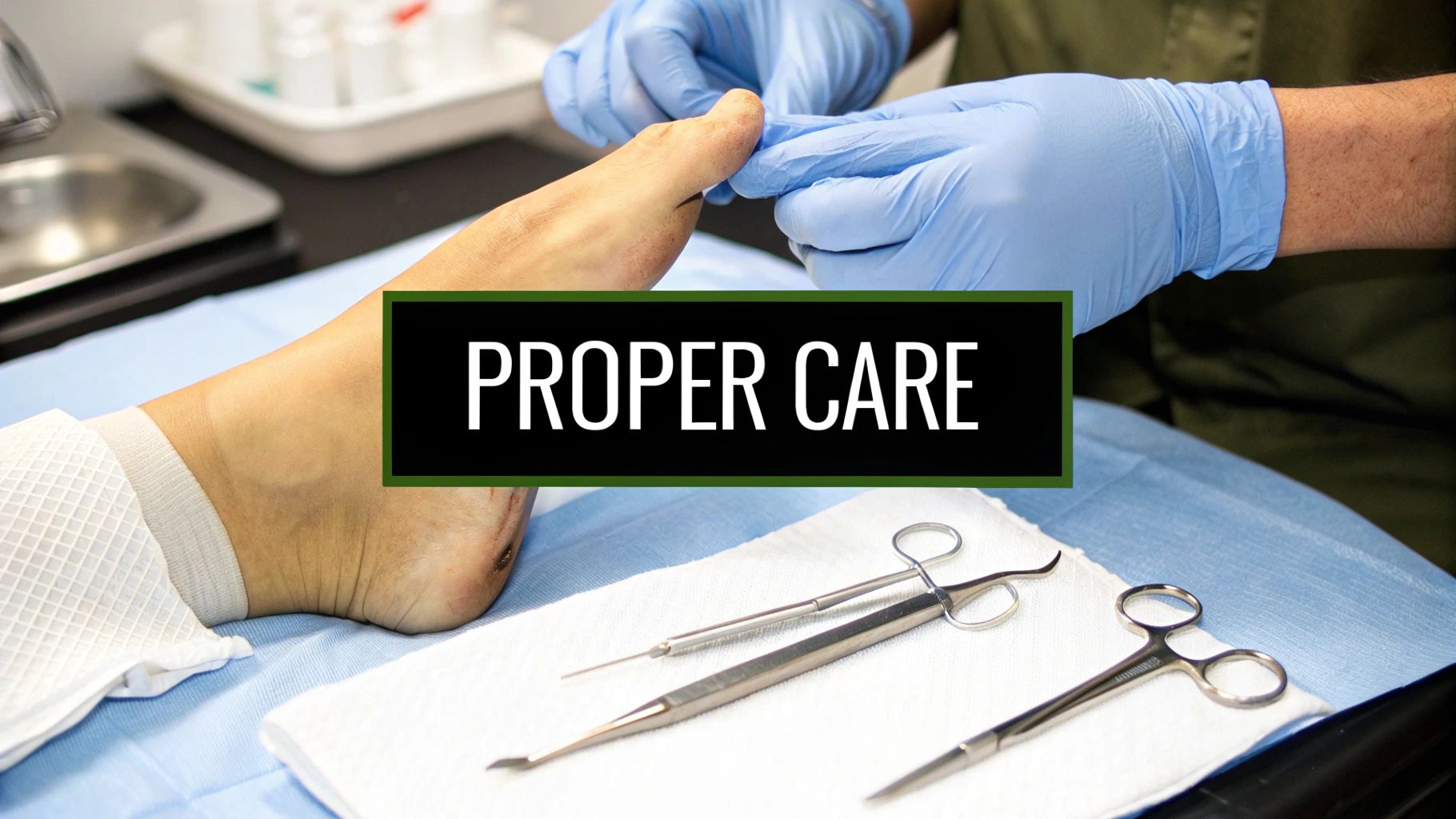Diabetes brings numerous health challenges, but the risk of diabetic foot wounds is particularly serious. These wounds aren’t just superficial injuries. They represent a complex combination of factors that can quickly become a major health issue. This often overlooked complication needs significant attention due to its potential for severe consequences.
One reason diabetic foot wounds are so concerning is neuropathy, or nerve damage. This loss of sensation means people may not feel pain from cuts, blisters, or other injuries. As a result, these minor wounds can go unnoticed and untreated, worsening over time. Furthermore, diabetes often affects circulation, hindering the body’s natural healing. This reduced blood flow to the feet makes it difficult for the body to deliver oxygen and nutrients needed for healing.
This combination of neuropathy and poor circulation creates a dangerous situation where minor injuries can become serious diabetic foot ulcers (DFUs). These ulcers can quickly get infected, deepening and spreading to surrounding tissues and even bone. A seemingly small blister, for example, can rapidly develop into a deep ulcer requiring specialized medical care. This highlights the critical importance of early detection and proper treatment of diabetic foot wounds. DFUs are a significant medical complication affecting a substantial number of people with diabetes.
The Alarming Statistics and Growing Concern
The statistics surrounding diabetic foot wounds are alarming. DFUs affect approximately 19% to 34% of people with diabetes during their lifetime. Globally, this translates to a substantial burden among the estimated 537 million individuals living with diabetes. Amputation rates, a devastating consequence of untreated DFUs, remain high. About 20% of patients with a DFU will undergo some form of lower-extremity amputation. The 5-year mortality rates range from 50% to 70%. Find more detailed statistics here The recurrence rate for ulcers is about 65% within three to five years after an initial ulcer. This points to an ongoing challenge in effectively managing and treating diabetic foot wounds.
The increasing number of amputations in certain regions and populations, especially among younger and minority groups, is particularly worrying. This emphasizes the need for greater awareness and access to specialized care. Early detection and intervention are essential for preventing serious complications.
Recognizing the Early Warning Signs
Early detection is crucial in treating diabetic foot wounds. Recognizing the subtle signs of a developing problem can significantly impact preventing serious issues. Changes in skin color, temperature, or texture, along with any signs of swelling, redness, or drainage, should be taken seriously. Even seemingly minor cuts or blisters shouldn’t be disregarded.
Regular self-exams are critical, especially for those with neuropathy who may not feel pain. Proper foot care practices, such as wearing suitable footwear and keeping feet clean and dry, are also important for minimizing risk. By understanding the risks and taking proactive steps, people with diabetes can significantly reduce their chances of developing these debilitating wounds and improve their overall well-being.
First Steps: Assessment That Guides Successful Treatment

Proper assessment is the cornerstone of effective diabetic foot wound treatment. This initial evaluation guides every treatment decision, impacting the chances of successful healing. A thorough assessment goes beyond simply observing the wound; it involves understanding the patient’s overall health and the wound’s unique characteristics.
Understanding Wound Classification Systems
Several classification systems help categorize these wounds, guiding treatment strategies. The Wagner Classification System and the University of Texas Wound Classification System are commonly used. These systems categorize wounds based on factors like depth, infection presence, and bone or tendon involvement. Accurate classification is essential, as misclassification can lead to ineffective treatment and slower healing.
To better understand these classification systems, let’s explore a comparison table. This table highlights key features, advantages, and clinical applications of the most common systems used for classifying diabetic foot wounds.
| Classification System | Key Features | Advantages | When to Use |
|---|---|---|---|
| Wagner Classification System | Classifies wounds based on depth and presence of infection or ischemia (0-5 scale) | Simple and easy to use in clinical practice | Assessing wound severity and guiding initial treatment decisions |
| University of Texas Wound Classification System | Considers wound depth, presence of infection, and ischemia (grades 0-III, stages A-D) | More detailed than Wagner, offering better differentiation | When a more comprehensive assessment is needed, especially for research purposes |
| PEDIS Classification System | Evaluates perfusion, extent/size, depth/tissue loss, infection, and sensation | Provides a holistic assessment considering multiple factors contributing to the wound | For complex wounds requiring a multidisciplinary approach |
This table highlights the distinct strengths of each system, demonstrating how they can be applied in different clinical contexts. Choosing the right system depends on the specific needs of the patient and the complexity of the wound.
Essential Components of a Thorough Wound Assessment
A thorough assessment includes documenting the wound’s size, depth, and location. It should also note the presence of necrotic tissue, exudate, or signs of infection. This detailed record establishes a baseline for monitoring healing. It allows healthcare professionals to track progress and adjust treatments as needed.
The Growing Impact of Diabetic Foot Ulcers
The importance of accurate assessments and effective treatment is underscored by the rising global impact of diabetic foot ulcers. The global prevalence of diabetic foot ulceration is around 6.3%, with approximately 18.6 million people developing these ulcers annually. This contributes significantly to increased hospitalizations, infections, and lower-extremity amputations. Learn more about this. The global diabetic foot ulcer treatment market, valued at about USD 8.83 billion in 2024, is projected to reach USD 14.37 billion by 2032. This growth is driven by factors like the increasing prevalence of diabetes, improved awareness, and the development of advanced wound care products.
Determining the Appropriate Level of Care
Not all diabetic foot wounds require hospitalization. Some can be managed with monitored home care. The initial assessment helps determine this. Factors like wound severity, infection presence, and the patient’s overall health inform this decision. For home-treated wounds, patient education on proper wound care and regular monitoring by healthcare professionals are crucial. A good initial assessment sets the stage for successful treatment and positive outcomes in managing diabetic foot wounds.
The TIME Framework: Core Principles That Drive Healing

Successfully treating diabetic foot wounds requires a systematic approach. This section explores the TIME framework, a crucial methodology in wound care. This framework provides a structured approach for addressing the many factors affecting wound healing. It guides both clinicians and patients, ensuring comprehensive and effective care.
Tissue Management: Debridement and Beyond
The “T” in TIME stands for Tissue Management. This involves removing dead or damaged tissue, a procedure known as debridement, which is essential for healthy new tissue growth. Debridement prepares the wound bed for healing. It’s similar to preparing a garden bed for planting – clearing debris is necessary for optimal growth.
Various debridement methods exist, each tailored to different wound types. Some techniques involve surgical removal, while others utilize enzymatic dressings to break down the unhealthy tissue.
Inflammation Control: Managing the Body’s Response
Inflammation is the body’s natural response to injury and is vital for the healing process. However, chronic inflammation can actually hinder healing. The “I” – Inflammation Control – focuses on managing this delicate balance.
Think of inflammation control like adjusting a burner on a stovetop. Too low, and nothing cooks; too high, and everything burns. This might involve managing infection with appropriate medications, offloading pressure from the wound, and maintaining optimal blood sugar control.
Moisture Balance: Creating the Right Environment
Maintaining the right moisture balance is crucial for wound healing. Too much moisture can lead to maceration, softening and breaking down the skin. Conversely, too little moisture can impede cell growth. The “M” in TIME emphasizes this critical balance.
Finding the right moisture balance is like the “Goldilocks” principle – not too wet, not too dry, but just right. This optimal environment promotes cell migration and the rebuilding of damaged tissue. Dressings that maintain appropriate moisture play a vital role, protecting the wound and fostering a healing environment.
Edge Advancement: Closing the Wound
Finally, “E” represents Edge Advancement, focusing on techniques to effectively close the wound. Different strategies may be used based on the wound’s characteristics and the patient’s health. Some wounds may benefit from specialized dressings that encourage skin cell migration, while others may require surgical closure or skin grafts.
Surgical intervention is often necessary for individuals who develop diabetic foot infections as a complication of diabetic foot ulcers (DFU). Unfortunately, 15% to 20% of these infections lead to amputation. This underscores the seriousness of these infections and the critical need for timely and effective treatment. More detailed statistics can be found here: https://pmc.ncbi.nlm.nih.gov/articles/PMC9797649/
The TIME framework offers a structured approach to treating diabetic foot wounds, highlighting the interconnectedness of these four principles. This holistic perspective recognizes that effective treatment requires addressing all aspects of the TIME framework concurrently. Each element works in tandem with the others to promote optimal healing and minimize the risk of serious complications.
Breaking Through Healing Plateaus With Advanced Therapies

Sometimes, even with diligent standard care, diabetic foot wounds can plateau in their healing. This can be a source of anxiety for patients. Fortunately, there are effective solutions. Advanced therapies offer new hope for wounds resistant to conventional treatments.
Exploring Advanced Treatment Modalities
Several advanced therapies are improving the outlook for diabetic foot wound care. Key examples include negative pressure wound therapy (NPWT), hyperbaric oxygen therapy (HBOT), and bioengineered skin substitutes. For persistent non-healing wounds, regenerative medicine techniques like Cell-Based Therapy offer further options.
NPWT, also known as vacuum-assisted closure, uses suction to remove excess fluid. This promotes blood flow to the wound bed, creating an environment conducive to new tissue growth.
HBOT involves breathing pure oxygen in a pressurized chamber. This saturates the blood with oxygen, facilitating new blood vessel formation and combating infection, particularly helpful in wounds with compromised blood flow.
Bioengineered skin substitutes offer a novel approach. These lab-grown tissues act as a temporary wound covering. This shields the wound and encourages the body’s natural skin regeneration.
Comparing Advanced Treatment Options
The following table outlines various advanced therapies for diabetic foot wounds, their mechanisms, efficacy, patient selection criteria, and cost considerations.
| Treatment Modality | Mechanism of Action | Typical Efficacy Rate | Patient Selection Criteria | Cost Considerations |
|---|---|---|---|---|
| Negative Pressure Wound Therapy (NPWT) | Removes excess fluid, stimulates blood flow | Varies depending on wound characteristics, typically high | Wounds with moderate to heavy drainage, deep wounds | Moderate to high |
| Hyperbaric Oxygen Therapy (HBOT) | Increases oxygen delivery to tissues | Improves healing in many cases, especially with compromised blood flow | Wounds with poor circulation, chronic infections | High |
| Bioengineered Skin Substitutes | Provides a temporary wound covering, promotes cell regeneration | High success rates in closing complex wounds | Large, deep wounds, slow-healing wounds | High |
This table offers a general overview. A physician will determine the actual efficacy and patient suitability on a case-by-case basis.
Accessing Advanced Therapies
While these therapies offer significant benefits, navigating insurance coverage and locating specialized wound care centers can present challenges. Advocating for these treatments, when appropriate, can significantly improve patient outcomes. Resources exist to help patients understand available options and connect with specialized centers. With information and proactive engagement, individuals can improve their healing journey and reduce the risk of serious complications.
The Dream Team: Building Your Wound Healing Alliance
Treating diabetic foot wounds effectively requires a coordinated team of specialists. Each member plays a vital role in healing the wound and preventing recurrence. This team-based approach, used by leading medical centers, has significantly reduced amputation rates and improved patient outcomes.
Essential Members of the Wound Care Team
The “dream team” composition varies based on individual needs and wound complexity. However, several key specialists are typically involved:
- Endocrinologist: Manages the patient’s diabetes and optimizes blood sugar control, essential for wound healing. The endocrinologist ensures the body is properly regulated for optimal healing.
- Vascular Surgeon: Addresses circulation problems, a common issue in diabetes that can impair healing. Restoring blood flow allows nutrients and oxygen to reach the wound.
- Podiatrist: Provides specialized foot care, including debridement, wound dressings, and offloading techniques. The podiatrist focuses on the foot’s structure and function to support healing.
- Wound Care Nurse: Monitors the wound, provides hands-on care, and educates the patient about proper wound management. The wound care nurse provides consistent care and prevents complications.
Other professionals, such as infectious disease specialists, physical therapists, and dietitians, may also be involved depending on the individual’s specific needs.
Coordinating Care: The Key to Success
Effective communication and collaboration between team members are crucial. Regular meetings, shared medical records, and clear communication protocols ensure everyone is working together effectively. This minimizes the risk of gaps in treatment that can hinder progress.
Building Your Alliance, Even with Limited Resources
Even with fewer specialists available, building a core team is still possible. A primary care physician can lead, coordinating with available specialists. Identifying the essential team members for the patient’s unique situation is key.
Practical Tools for Team Communication and Referral
Practical tools can facilitate communication and referrals:
- Communication Templates: Standardized forms for sharing information between providers.
- Referral Timing Guidance: Clear guidelines on when to refer a patient to a specialist.
- Care Coordination Strategies: Strategies for organizing appointments and information flow between multiple providers.
By proactively building a strong care team, individuals with diabetic foot wounds can improve their healing chances, reduce complication risks, and protect their overall health. Building this team is especially important for long-term care. You can find helpful tips on providing care for the elderly at Caring Hands Senior Services.
Beyond Healing: Creating Your Recurrence Prevention Plan
Successfully treating a diabetic foot wound is a major accomplishment. But the real victory lies in preventing future issues. This section offers a plan to break the cycle of recurrence, which affects 65% of patients.
Daily Self-Examination: Your First Line of Defense
Regular self-exams are essential. Think of them like checking your car’s oil – routine maintenance prevents major problems. Daily foot inspections can catch potential issues early. Look for changes in skin color, temperature, or texture. Also, note any swelling, redness, or new sores, no matter how small. Building a strong support system is crucial, especially for long-term care. You may find helpful resources for providing compassionate care for the elderly.
Footwear: The Foundation of Prevention
Proper footwear is the cornerstone of a solid recurrence prevention plan. Shoes should fit well and provide excellent support, distributing pressure evenly. Think of your shoes as shock absorbers, cushioning your feet from impact. Avoid shoes that are too tight, too loose, or have seams that could rub and cause sores. Custom orthotics can further improve comfort and support, especially for those with foot deformities.
Moisture Management: Maintaining Skin Integrity
Maintaining proper moisture balance is critical. Dry skin tends to crack, creating openings for infection. Moisturize your feet daily, but avoid applying lotion between your toes, as this can encourage fungal growth. Keeping feet clean and dry helps maintain skin health and reduces infection risk. This careful balance is key to preventing recurrence.
Follow-Up Care: Partnering with Your Healthcare Team
Set up a regular follow-up schedule with your healthcare team. The frequency of visits depends on your individual risk factors. Regular checkups allow for early detection of any recurring issues. These visits also give you a chance to discuss any concerns you may have. Open communication and collaboration are essential for long-term success.
Glucose Management: A Holistic Approach
Effective glucose management is vital, not just for overall health but especially for foot health. Maintaining stable blood sugar levels promotes healing and reduces the risk of complications. Think of it like properly fueling a car for a smooth-running engine. Consistent glucose management is a cornerstone of foot health and recurrence prevention.
Lifestyle Modifications: Building Sustainable Habits
Lifestyle changes play a major role in long-term prevention. Regular exercise improves circulation, bringing essential nutrients to your feet. A balanced diet supports overall health, boosting your immune system and aiding in healing. Managing stress helps regulate blood sugar. These sustainable changes build a foundation for lasting foot health.
Preventing recurrence is an ongoing journey, demanding commitment and a proactive approach. By following these steps, you can significantly reduce your risk and enjoy healthy feet for years to come.
Ready to take control of your wound healing? Rapid Wound Care provides comprehensive at-home wound care services, tailored to your individual needs. We offer advanced therapies and personalized treatment plans to promote healing and prevent recurrence. Visit Rapid Wound Care today to learn more.

